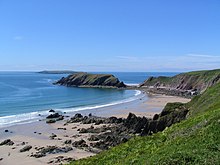Gate spar
Gateholm is a tidal island about eight miles west of Milford Haven off the southwest coast of Pembrokeshire in Wales . It is known for its Roman-British remains.
The name, which was handed down as Goteholme in 1480, comes from Old Norse and means "goat island". Vikings frequently invaded this area in the 9th and 10th centuries.
The approximately four hectare large and maximally 40 m high Gateholm is located at the western end of the Marloes Sands and is accessible via the Albion Sands at low tide . The island is made up of Old Red Sandstone . The exceptional exposure here and on the Albion Sands has resulted in the island being listed as a candidate for protection as a Geological Site of Special Scientific Interest ( SSSI ).
archeology
There are around 130 remains of round and rectangular huts on the island. The rectangular ones were mostly arranged in rows with small courtyards. Excavations of some huts in 1910 and 1930 found evidence of their use in Roman times, through finds of coins , pottery and a small bronze deer . Of particular interest was the discovery of a bronze needle of Irish origin from the 6th century. The houses were built of lawn with stone facades. In one of the houses was a stone phallus , buried upright in one of the post holes. The place was interpreted as a Roman-British settlement with later use as a monastery.
Nearby is the Hillfort Victoria Bay.
See also
Web links
literature
- Peter Caton: No Boat Required. Exploring Tidal Islands. Matador, London 2011, ISBN 978-1-84876-701-0 .
Coordinates: 51 ° 43 ′ N , 5 ° 14 ′ W

